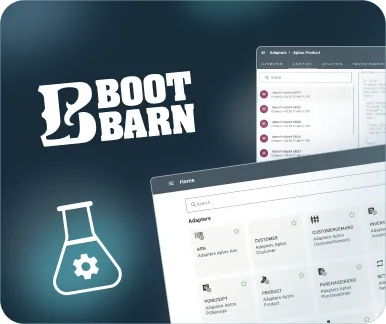Boot Barn Supply Chain Systems Testing
Standardization of test development — Success story
About the Company
Boot Barn Inc. is the largest seller of cowboy boots, hats, and cowboy and work attire in the US. The company owns two large online stores and over 550 physical stores and also sells via Amazon and eBay. It offers thousands of products and processes millions of orders each year.
The company's success is based on state-of-the-art Information Technology. The IT and eCommerce divisions develop and operate software systems that automate all business areas and perform most mission-critical tasks.

Challenges
Boot Barn’s supply chain systems required comprehensive testing across various complex functionalities, such as inventory management, order processing, and system integrations. Manual testing methods proved inefficient and time-consuming, increasing the risk of undetected defects and vulnerabilities that could disrupt operations.
Ensuring data accuracy during migration, synchronization, and across transactional records was essential to avoid inconsistencies that could lead to costly operational errors.
Boot Barn initially intended to develop automated tests using its internal expertise but faced the challenge of needing rapid implementation.
After evaluating the project timeline and budget, it became clear that boosting development productivity was essential to meet deadlines and stay within budget.
As a result, Boot Barn sought a solution that would allow multiple teams and developers to work in parallel on different testing components while maintaining consistency across their efforts.
The Solution We Proposed
To parallelize development, ensure consistency, and improve productivity, Enterprise Innovation Consulting, leveraging the Better Testing program, proposed a modular test architecture utilizing standardized templates and reusable design patterns. The technology stack, including PowerShell for scripting, Pester for unit testing, and Selenium for UI automation, was selected based on a combination of industry best practices, Boot Barn’s preferences, and the internal team’s experience.
What We Did
EIC began by developing the test architecture and documenting the overall testing approach, including a detailed test strategy and plan. To ensure consistency across teams, we implemented reusable templates and libraries, streamlining the testing process. By creating a vertical slice, we successfully parallelized the development process, enabling multiple teams to work efficiently in tandem. Finally, we conducted comprehensive training sessions for Boot Barn’s development teams, completing the entire implementation within just three months.
The Result
The implementation of the new test architecture significantly improved the efficiency of Boot Barn’s testing processes. Development teams were able to collaborate more effectively, reducing testing time and increasing productivity. The reusable templates and automated testing framework streamlined operations, ensuring better coverage and quicker identification of issues. This led to faster release cycles, improved system reliability, and greater confidence in the supply chain systems' performance. Overall, the solution enhanced both the quality and speed of Boot Barn’s testing efforts in supply chain systems.
Performance Improvements:
● Productivity Increase: A 2x improvement in the speed of test development and execution across teams compared to initial estimates.
● Time to Market: A 30% reduction in the time required to release new features and updates.
● Developer Onboarding Time: A 40% reduction in the time required to onboard new team members into the testing framework.
● Automation Coverage: A 50% increase in test coverage through automation, ensuring critical systems are fully tested.

Testimonial

Nick Jimenez
Director of Development and Integrations
Boot Barn Inc.
Partnering with EIC completely transformed Boot Barn’s supply chain testing.
EIC introduced reusable templates and libraries that streamlined everything.
By enabling teams to work in parallel and implementing automated testing, we were able to catch issues earlier and speed up release times.
In just a few months, we went from inefficient testing to faster, more reliable systems.
EIC’s solution gave us the confidence we needed in the stability and performance of our supply chain.

